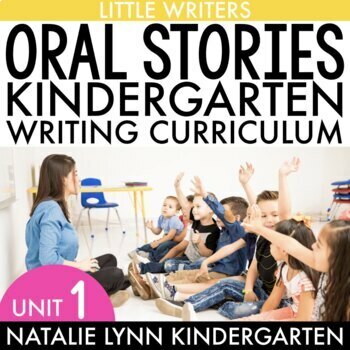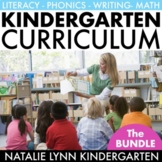Speaking and Listening Oral Language Unit Kindergarten Writing Curriculum
- PDF
What educators are saying
Also included in
- Implement your kindergarten writing curriculum with ease - my Kindergarten Writing Curriculum Bundle makes kindergarten writer’s workshop engaging for even the most resistant writer! Each unit includes lesson plans, mentor text suggestions, anchor charts, writing paper, and rubrics. My writing unitPrice $28.00Original Price $56.00Save $28.00
- Teaching kindergarten has never been easier! This kindergarten complete curriculum bundle includes systematic, research-based, age-appropriate, and EFFECTIVE curriculum for kindergarten. Everything you need to teach effective lessons in kindergarten is included.This curriculum is designed with classPrice $250.00Original Price $440.00Save $190.00
Description
A strong oral language foundation is essential for success in writing! Before students begin putting their stories on paper, they need to be able to TELL their stories. This Speaking and Listening writing unit will focus on how to be a speaker, how to be a listener, and how to tell a detailed story - before students ever put pencil to paper!
This unit is the perfect way to begin writer's workshop at the beginning of kindergarten in a developmentally-appropriate way. It leads right into Unit 2: Stories in Pictures.
⭐Pre-Writing Handwriting Lessons Included! This writing unit includes 10 handwriting lessons that focus on pre-writing handwriting strokes. Students will love meeting the Handwriting Friends and hearing their original poems.
Find the year-long bundle here: Kindergarten Writing Curriculum for the Year
Unit 1 Lessons:
1. Writers Tell Stories About Their Lives
2. Being a Speaker
3. Being a Listener
4. Stories Have a Character and Setting
5. Stories Have a Beginning and End
6. Stories Have Events
7. Writers Tell About Their Feelings
8. Listening and Responding
9. Asking Questions
10. Writers Plan Out Their Stories
Handwriting Lessons Included:
- Straight lines
- Straight lines
- Straight lines
- Plus Signs
- Circles
- Squares
- Slants
- Slants
- X's
- Triangles
What's Included:
- Writing Lessons Plans for 10 Days
- Pre-Writing Handwriting Lesson Plans for 10 Days
- Anchor Chart Pieces
- Posters
- Story Icons
- Optional Writing Paper
- Handwriting Strokes Practice Pages
- Turn and Talk Procedures
- Conferring Notes
- Rubrics
Mentor Texts (not included):
•“Ralph Tells a Story” by Abby Hanlon
•“One Day. The End.” by Rebecca Kai Dotlich
FREQUENTLY ASKED QUESTIONS:
Will students be writing in this unit?
That is optional for this unit. This unit focuses on speaking and listening, but I understand that you may still want to give your students some practice on paper. Each lesson has the option to have students draw the story they tell daily, but you will not explicitly teach how to tell a story through pictures yet. I know it’s tempting to begin teaching how to draw detailed pictures or add words, but I caution you not to “over-teach” during this unit.
Why should I begin the year with an oral language writing unit? Before our students can write a story, or even draw it, they need to be able to TELL it! This is developmentally appropriate for our little learners. It may take a little longer at the beginning of Kindergarten, but it will save you so much time in the long run as your students are able to think through their stories.
What would a daily lesson look like?
Lesson plans are laid out in this way:
- Introduction (1-5 minutes): This is when the teacher will introduce the objective. It may include reading a mentor text.
- Mini Lesson (5 minutes): This is the teacher-led portion of the lesson. The teacher may be completing a shared speaking or writing activity with students.
- Partners (2 minutes): Students will complete a turn and talk with a partner. In this unit, this is the meat of the lesson.
- Optional Writing: In this unit, writing is optional. You can have students begin drawing their stories to build stamina. Do not worry yet about details in these pictures.
What does a handwriting lesson look like?
The handwriting lessons are very brief and will focus on one pre-writing handwriting stroke each day. These will take around 5-10 minutes maximum.
- Teacher Led: The teacher will introduce the Handwriting Friend and read the poem. They will show students how to make the handwriting line.
- Optional hands-on practice: Students can practice the stroke in a hands-on way including writing it on paper, on dry erase boards, with chalk, and with paint.
- Prewriting Worksheet: A handwriting worksheet is included each day. Students can practice tracing the lines and then writing the lines on their own.
What posters are included:
- Speakers
- Listeners
- Characters
- Setting
- Story Ideas
- Listeners Respond
- Handwriting Lines
Anchor chart pieces included:
- Story Ideas
- Speakers and Listeners T Chart







